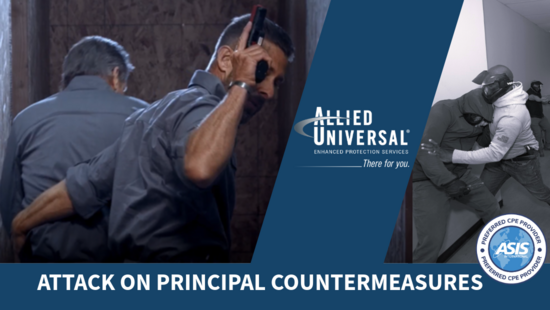
ATTACK ON PRINCIPAL COUNTERMEASURES (ATC-201)
Outline
ATTACK ON PRINCIPAL COUNTERMEASURES (ATC-201)
The Attack on Principal Countermeasures (ATC-201) is an intensive three-day training program designed to equip executive protection agents with the critical skills and tactical mindset necessary to effectively respond to an attack on principal scenario. As targeted assaults on high-profile individuals continue to rise, often with the intent to cause lethal harm, public humiliation, or physical violence, the need for highly trained and adaptable protection professionals has never been greater.
This course emphasizes proactive threat mitigation strategies, focusing on the vulnerabilities created by time-place predictability and accessibility. Participants will learn how to identify and disrupt patterns that adversaries exploit, and how to implement dynamic countermeasures that reduce exposure and ultimately how to reduce or mitigate an attack. Through scenario-based training, agents will gain the confidence and competence to make rapid decisions under pressure, ensuring the safety of their principal in threatening environments.
The training program was designed and developed utilizing the best practices, tactics, techniques, and procedures of our internal subject matter experts (SMEs), federal, state, and municipal-level public safety organizations, military special operations, and private sector security organizations
PURPOSE
This 3-day training program is designed to deliver a comprehensive blend of armed and unarmed response skills to agents for the purpose of safeguarding Principals and the public during an attack on principal event under various environmental conditions.
This unique, modular training program is delivered via a hybrid combination of live, instructor-led instruction and challenging field exercises. The program culminates with a capstone full-mission-profile Situational Training Exercise (STX) in which students will be evaluated on the entire spectrum of skills encompassed by the curriculum.
WHO SHOULD ATTEND?
For security professionals desiring the skills to provide protection for principals, clients, and corporations during an active shooter or threat. For acceptance to attend this course, the student must have a legal right to be employed in the United States and be a minimum of 18 years of age. Students must provide a valid government identification (i.e. driver license, passport, military identification, public safety credentials, etc.) that displays the student’s date of birth and a photograph. Students should be competent and confident in the use of their primary firearm. (No live fire training will occur during this course)
LEARNING OBJECTIVES
Given organizational best practices and mission essential equipment, properly provide armed and unarmed response to an active shooter/threat attack while providing executive protection services for principals, clients, and corporations.
- Explain roles and responsibilities of the Executive Protection Agent.
- Understanding and developing the Agent’s Awareness Sheild
- Identify pre-incident indications and postures
- Demonstrate De-escalation tactics during a potentially volatile situation.
- Demonstrate concepts and principles as a single agent or member of an EP Team for movement with a principal.
- Demonstrate concepts and principles for arrival and departure procedures from a vehicle.
- Threat mitigation procedures during walking movements, arrivals and departures and corporate settings.
- Demonstrate concepts and principles of legally defendable counter assault on principal tactics.
- Demonstrate single-agent/multiple-agent cover and evacuation of a principal
- Demonstrate single-agent and multiple-agent room entry tactics, with and without Principal.
- Demonstrate "hard-point" best practices with a principal (“Hard Point” selection, properly barricade, agent/principal positioning).
- Demonstrate the executive protection agent’s role during an active shooter/threat attack in a corporate setting.
- Demonstrate proper and safe pistol handling during high threat events, movement and attack on principal counter assault tactics
- Explain the importance of “stop the bleed”, and other medical conditions concept’ s after an attack on principal.
- Explain the law enforcement response and interaction after an attack on principal incident.
- Perform in multiple Executive Protection Reality Based Scenarios.
METHODOLOGY
· Lecture/Demonstration – A training situation in which an instructor presents students with material and generates class discussions.
· Practical Laboratory – A non-graded training situation, in which students practice skills under the guidance of an instructor.
· Practical Examination – A graded training situation, in which students are evaluated by an instructor(s), through practical application, to determine their mastery of performance objectives.
· Written Examination – A graded training situation, in which students are evaluated by an instructor(s), through a written evaluation, to determine their mastery of performance objectives.
REQUIRED EQUIPMENT
- Durable clothing to include pants with belt loops. Long sleeve shirt.
- Gun belt
- Eye protection
- Ear protection
- Flashlight
PROHIBITED ITEMS
The following items must be secured outside the training area:
· All weapons (including firearms, knives, OC spray, impact weapons, etc.)
· Jewelry (including watches, necklaces, and earrings)
GENERAL HEALTH AND SAFETY
· Attendees must be in good physical condition and should consult a doctor with any questions regarding their ability to safely participate in defensive tactics training.
· Pre-existing injuries should be disclosed prior to participation to reduce likelihood of reinjury.
· Attendees who are not employed by Allied Universal must sign a liability release prior to participating in this training.
TRAINING HOURS
This is an intensive course totaling 24-hours, 8-hour training days. Training typically runs from 8:00am to 5:00pm.
REGISTRATION
Open-Enrollment Registration: Tuition is $1,200.00. Please note that your seat will not be reserved until tuition is received. Tuition is refundable up to 30 days prior to training. Open-enrollment participants are responsible for their own travel, accommodations, and personal insurance (if desired).
EPS Registration: Employees of Allied Universal Enhanced Protection Services who have been approved to attend this training through their supervision may do so tuition-free.
STUDENT BULLETIN
Following registration for this course, you'll receive a confirmation email and a preliminary student bulletin which will include additional program details, guidelines, expectations, and required equipment. If you have any questions, please email john.lower@aus.com
Please see our events catalogue for current courses.
